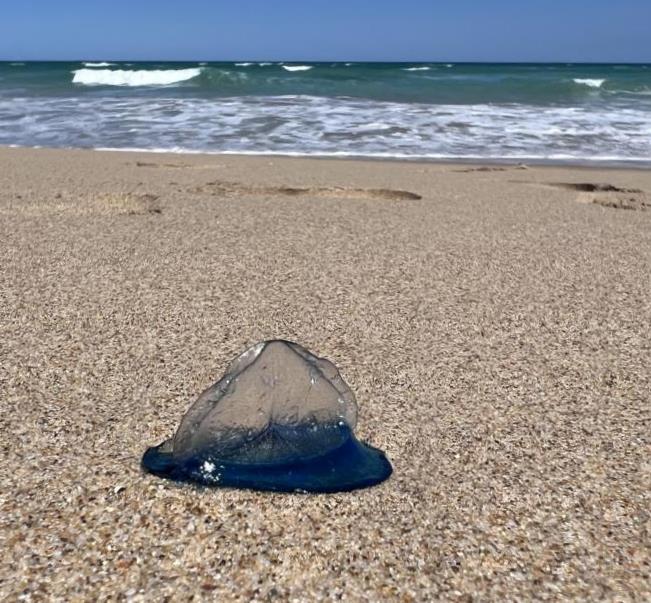The bluebottle jellyfish, also known as Physalia utriculus, is commonly found along the coasts of non-tropical regions bordering the Atlantic, Indian, and Pacific oceans. These creatures are not jellyfish but rather siphonophores, which are composed of multiple organisms known as zooids. These zooids work together in unison and rely on each other to function properly. They each serve different purposes such as floating, feeding, reproduction, and stinging.



Despite their small size of about 10 cm/ 4”, bluebottle jellyfish have tentacles that can stretch up to 3 meters (9 feet) long. These tentacles are equipped with stinging cells that contain barbs and neurotoxic venom. When the jellyfish drifts downwind, its tentacles float beneath it. They wait to come into contact with prey such as small fish, squid, small crustaceans, or larger surface plankton. Once prey is touched, it is immobilized by the venom. The jellyfish then uses contracting muscles to lift the tentacle and transport the prey to the digestive polyps located below its floating body.
What happens when humans are stung by blue bottles?
When humans come into contact with these stinging cells, the resulting pain can be exceptionally intense and last for up to an hour. These stings can occur both in the water and on land, such as when touching the tentacles. Depending on which part of the body is stung, the effects can range from a mild rush to blisters and swelling, and in serious cases, can lead to medical issues. The pain may also be felt in the lymph glands that drain the affected region. In most cases, professional medical treatment is advised.
The best way to prevent stings is to avoid entering the water when bluebottle jellyfish are present on the beach and to avoid touching any stranded bluebottle tentacles.
Removing bluebottle sting cells
In case of a sting, it is important not to use alcohol, vinegar, or freshwater to remove any remaining tentacles from the skin, as this can cause more venom to be released. Instead, it is recommended to use saltwater or salted fresh water to clean the affected area. It is important to ensure that the washing water does not run down the legs, as some of the nematocysts can cause further damage to the feet. Before attempting to remove any tentacle parts by hand, it is advisable to protect the fingers with a rubber glove or other protective items.
It is recommended to scrape off any remaining nematocysts on the skin with the edge of a knife, credit card, or other sharp object. This should be done carefully and gently. Care should be taken not to apply too much pressure or further irritate the affected area. After removing the nematocysts, it is advisable to wash the area again with saltwater or salted freshwater. And professional medical attention has to be sought if necessary.
An old lifeguard trick involves sprinkling sea sand on the remaining tentacles. By gently rubbing the sting cells, they should be scraped off the skin. While this method can be painful, it is still better than leaving the sting cells in place. It is however important to note that the use of sea sand is not a scientifically proven method. And it has not been recommended by medical professionals.
Possibilities to reduce pain induced by the venom
If no tentacle parts are remaining on the skin, the effect of the venom can be reduced by immersing the affected body part in salted water. The water temperature should be around 45°C. And the body part should be immersed for an hour or longer, or until the symptoms subside. However, this temperature may be too hot for many people to tolerate. In such cases, other suitable heating sources, such as first-aid heat packs, can be used to provide relief.
Other possibilities for relieving the pain caused by Bluebottle jellyfish stings:
- Detergent liquids such as “Handy Andy” from Unilever or similar products can be effective.
- A paste made from meat tenderizer mixed with water can help.
- It is said that urinating directly on the affected area can relieve the pain.
- Applying topical anesthetic cream or corticosteroid cream to the affected area may also help.
- Taking oral antihistamines may provide relief.
Stranded bluebottles are being eaten up very soon
There is one creature that does not fear bluebottles but enjoys them: the plow shell sea snail, which includes species such as Bullia digitalis. These scavenger snails have a keen sense of smell and can detect the scent of bluebottle carcasses from a distance. Working together in packs, they can completely consume a blue bottle – including its bladder, polyps, and tentacles – within a matter of days. To get a better idea of how quickly these snails move, you can watch the attached video.
Lessons learned from Bluebottle jellyfish:
- If you see blue bottles stranded on the beach, it’s best to avoid swimming in the sea.
- Make sure to pack thick rubber gloves, meat tenderizer, and/or some Handy Andy in your beachcombing survival bag.
- The plow shell sea snail (Bullia digitalis) is a helpful ally when seeking revenge against bluebottles.



